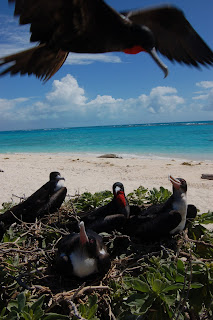 photo by kelli burkinshaw (www.flickr.com/kburki)
photo by kelli burkinshaw (www.flickr.com/kburki)And they're off! Twelve tags are currently transmitting from 7 black-footed and 5 Laysan albatrosses, all of which are tending to a nest with an egg. They're off to a big start, flying incredible distances over short periods of time. Many of the tagged birds had been incubating for a few weeks waiting for his/her partner to return to the nest, and now it's their own turn to take 2-3 weeks at sea to forage in the productive waters of higher latitudes and resupply their energy stores. Albatrosses are so efficient at flight that a trip to Japan or the Gulf of Alaska costs them, energetically-speaking, almost nothing; sure beats $4.00/gallon for petrol!
Albatrosses are designed to fuel their flight by a play between gravitational pull and the updraft produced by wind off the waves, and they are soaring specialists with very long, slender wings. They are able to lock their wings in place while in gliding/soaring flight, which minimizes energy expenditure which would be lost in holding the wings up otherwise.

Laysan albatrosses are more oceanic than black-footeds and tend to forage in the transitional waters where the subtropical frontal zone and the subarctic frontal zone meet and create a turbulent, mixed zone high in productivity, which, for an albatross means gooood eatin'. They also forage near the confluence of the Oyashio current coming down along the northern Japanese coast and the Kuroshio current, coming up along the southern part of the Japanese coast. These two N-S and S-N currents meet right at the shelf where there is a huge upwelling system, and so these waters are extremely productive and are frequented by albatross and man alike, not to mention a whole other host of marine predators.
 Black-footed albatrosses forage closer to the North American coast, typically in the Gulf of Alaska and near the Aleutians, or further south along the coast of Washington, Oregon and even my home state of California, dipping into the rich supply of food that the California current brings.
Black-footed albatrosses forage closer to the North American coast, typically in the Gulf of Alaska and near the Aleutians, or further south along the coast of Washington, Oregon and even my home state of California, dipping into the rich supply of food that the California current brings. The tracks below are examples of a few birds that are being followed right now. The purple tracks on the east are of black-footeds and the yellow track west is that of a Laysan (ignore the outlier points going into russia). Combined, they have covered over 15,000 miles from Tern Island ,thus far. That's over four times the distance from Anchorage to Los Angeles, a trip which my boyfriend and I took 3.5 weeks to complete in a car. Pretty respectable distances.

Onward and upward little albatrosses! More tracks will be posted as the season progresses.






























